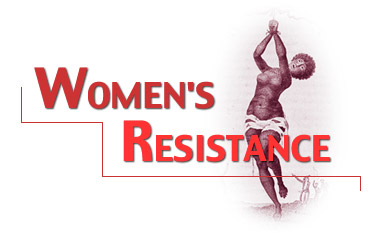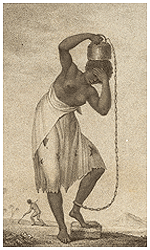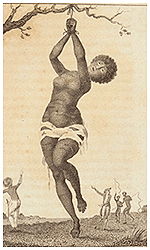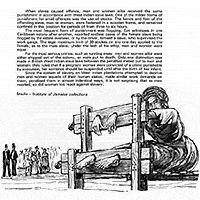 | 
 |
Slavery is terrible for men, but far worse for women. Such a strong and potent remark, but a quote that bears some factual evidence in regards to the suffering enslaved women had to endure. Slavery was an experience of mental, emotional, psychological and physical rape. Torture came in many forms and the affected male and female slaves in various ways. When torture became too unbearable slaves took great actions to annihilate the pain. However these actions came at a high price, and for many, the cost proved to be fatal.
 In this essay I will attempt to discuss the punishments inflicted upon slave women. This is not an easy task, for many reasons. Most primary sources do not distinguish between female and male slaves in respect to the various punishments inflicted on the enslaved. Written laws did not distinguish between the penalties inflicted on the slaves who committed "crimes." Nor did masters and overseers always distinguish between the two: " It is asserted by Dalrymple, that the drivers, in using their whip, never distinguish sex." In this essay I will attempt to discuss the punishments inflicted upon slave women. This is not an easy task, for many reasons. Most primary sources do not distinguish between female and male slaves in respect to the various punishments inflicted on the enslaved. Written laws did not distinguish between the penalties inflicted on the slaves who committed "crimes." Nor did masters and overseers always distinguish between the two: " It is asserted by Dalrymple, that the drivers, in using their whip, never distinguish sex."
Yet differences existed. Women bore many burdens during slavery. In addition to coerced labor, and punishment. They had to take care of their children, their families, and they also faced the ever-present threat of sexual exploitation. In fact, many of the punishments inflicted on women involved some form of sexual overtones. In many cases it seems that the overseer or master or other white person responsible for inflicting pain would experience some form of sexual excitement. "Scarce clothing because of poverty, bending over to work or lifting one’s dress to keep it clean…were seen by the slave holder in sexual terms. So Henry Bibb, an enslaved African, suggests, reporting in his narrative that a master made the comment that he would rather paddle a slave woman than eat food.
Among all the punishments faced by enslaved women, whippings were the most common, or at least the most talked about. The whip used was made of plaited cow-skin. Some overseers report that it was so strong, that it could take the skin off horses back, or lay marks in a "deal board." At times women ran away to protest whippings or escape other mistreatment. Running away was looked at as a serious crime, and many slaves were punished in various ways. Some female slaves was punished so badly that they were left to die. An observer remembered "a woman lying down and groaning…her left side, where she had been most whipped appeared in a most mortifying state, and almost covered with worms." Slave owners and overseers also assaulted enslaved women with ebony brushes, which were known to be far worse than thorn brushes. The back of one slave woman in Jamaica, flogged with such a brush, was described as being taken off, down to her heels.
 Some women ran away while others destroyed the planter’s property. Killing livestock (field) was one such form of active resistance. They faced horrific punishments if caught, including the cutting off of ears, and the pulling out of teeth. Women who resisted by raising their hands to the master, or any white person, for that matter, were punished severely: if not by death, their hands would be amputated. This form of amputation would also be administered to slaves who stole. "At Maumee bay in Jamaica, a female slave with but only one hand, the other having being cut off…white woman swearing that the slave had struck her." Some women ran away while others destroyed the planter’s property. Killing livestock (field) was one such form of active resistance. They faced horrific punishments if caught, including the cutting off of ears, and the pulling out of teeth. Women who resisted by raising their hands to the master, or any white person, for that matter, were punished severely: if not by death, their hands would be amputated. This form of amputation would also be administered to slaves who stole. "At Maumee bay in Jamaica, a female slave with but only one hand, the other having being cut off…white woman swearing that the slave had struck her."
In some cases, enslaved women did not commit any offense. Some planters were blatantly sick and sadistic in the severity of the actions that they took. In one case in Jamaica, a narrator describes a slave woman, screaming and suspended by her wrists on a tree. She swayed back and forth. The observer saw no sign of whippings, but upon looking closer he was horrified to see that the master was "seemingly motionless" and was holding a stick of fire in his hand to which he occasionally touched her with it as she swung.
One might be curious: what type of person was behind this kind of abuse? Was it only men, for instance, who carried out such tortures? In fact, white women also practiced and performed the acts of punishments. One would think that because of their gender similarities, the white woman would have some form of compassion and pity for the unfortunate slave woman. However, many whites during slavery in the Caribbean apparently did not consider slaves to be human. Domestic slave girls were the ones most often subjected to abuse by the white mistress in the home. These women were not viewed as women in low order; Blake reminds us, but women of respectability and rank. "Several negro girls at work with the needle in the presence of their mistress, with a thumb screw on their left thumbs and he has seen the blood gush out from he ends of them."
 Another from of domestic punishment inflicted by white mistresses on enslaved women was to have the domestics kneel with their bare knees on pebbles and work that at the same time in that manner. In one graphic incident, two white sisters in Barbados were displeased at one of their female slaves: " with their own garters they tied the young woman’s neck and heels, and then beat her almost to death with the heels of their shoes, one of her eyes continued a long while afterward in danger of being lost" Another from of domestic punishment inflicted by white mistresses on enslaved women was to have the domestics kneel with their bare knees on pebbles and work that at the same time in that manner. In one graphic incident, two white sisters in Barbados were displeased at one of their female slaves: " with their own garters they tied the young woman’s neck and heels, and then beat her almost to death with the heels of their shoes, one of her eyes continued a long while afterward in danger of being lost"
Perhaps worse than almost anything else was the constant threat of rape, a subject mentioned again and again in the primary sources. Slave women who rejected the planter’s advances were often raped, flogged or both. Punishment of this nature would be up to the whim of the master. Planters had wives, and these women would have severe animosity when such encounters occurred, whether willing or forced. The feelings of the planters’ wives contributed to their cruelty toward slave women. What could a person have done to deserve such fate? The actions taken by the planter class show the sick mentality and immense hatred they possessed for the blacks whether male or female. But chaotic punishments and assaults, unmentioned though they were in legal laws or rules, singled out women for the worst treatment of all slaves. The female slave’s misery was endless and her fate uncertain, for she had even more to bear than the male slave.
|
Maulana Karenga, Intro to Black Studies.Los Angeles, California, 1993.
W.D Blake. The History of slavery and the slave trade. Columbus, Ohio, 1862.
|

 |





